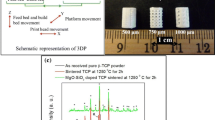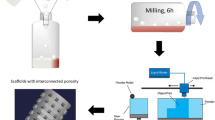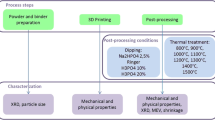Abstract
In this study, the effects of 3D-printed SiO2 and ZnO-doped tricalcium phosphate (TCP) scaffolds with interconnected pores were evaluated on the in vivo bone formation and healing properties of a rabbit tibial defect model. Pure and doped TCP scaffolds were fabricated by a ceramic powder-based 3D printing technique and implanted into critical sized rabbit tibial defects for up to 4 months. In vivo bone regeneration was evaluated using chronological radiological examination, histological evaluations, SEM micrographs, and fluorochrome labeling studies. Radiograph results showed that Si/Zn-doped samples had slower degradation kinetics than the pure TCP samples. 3D printing of TCP scaffolds improved bone formation. The addition of dopants in the TCP scaffolds improved osteogenic capabilities when compared to the pure scaffolds. In summary, our findings indicate that the addition of dopants to the TCP scaffolds enhanced bone formation and in turn leading to accelerated healing.







Similar content being viewed by others
References
A. Bandyopadhyay, S. Bernard, W. Xue, and S. Bose: Calcium phosphate-based resorbable ceramics: Influence of MgO, ZnO, and SiO2 dopants. J. Am. Ceram. Soc. 89, 2675–2688 (2006).
S. Bose, S. Tarafder, S.S. Banerjee, N.M. Davies, and A. Bandyopadhyay: Understanding in vivo response and mechanical property variation in MgO, SrO, and SiO2 doped β-TCP. Bone 48, 1282–1290 (2011).
Q. Liu, L. Cen, S. Yin, L. Chen, G. Liu, J. Chang, and L. Cui: A comparative study of proliferation and osteogenic differentiation of adipose-derived stem cells on akermanite and β-TCP ceramics. Biomaterials 29, 4792–4799 (2008).
Y. Huang, X. Jin, X. Zhang, H. Sun, J. Tu, T. Tang, J. Chang, and K. Dai: In vitro and in vivo evaluation of akermanite bioceramics for bone regeneration. Biomaterials 30, 5041–5048 (2009).
D.W. Hutmacher: Scaffolds in tissue engineering bone and cartilage. In The Biomaterials: Silver Jubilee Compendium (Elsevier, New York, New York, 2006); pp. 175–189. https://doi.org/10.1016/B978-008045154-1.50021-6.
S. Tarafder, V.K. Balla, N.M. Davies, A. Bandyopadhyay, and S. Bose: Microwave-sintered 3D printed tricalcium phosphate scaffolds for bone tissue engineering. J. Tissue Eng. Regener. Med. 7, 631–641 (2013).
V. Karageorgiou and D. Kaplan: Porosity of 3D biomaterial scaffolds and osteogenesis. Biomaterials, 26, 5474–5491 (2005).
B. Otsuki, M. Takemoto, S. Fujibayashi, M. Neo, T. Kokubo, and T. Nakamura: Pore throat size and connectivity determine bone and tissue ingrowth into porous implants: Three-dimensional micro-CT based structural analyses of porous bioactive titanium implants. Biomaterials 27, 5892–5900 (2006).
M. Bohner, Y. Loosli, G. Baroud, and D. Lacroix: Commentary: Deciphering the link between architecture and biological response of a bone graft substitute. Acta Biomater. 7, 478–484 (2011).
M. Bohner and F. Baumgart: Theoretical model to determine the effects of geometrical factors on the resorption of calcium phosphate bone substitutes. Biomaterials 25, 3569–3582 (2004).
S. Bose, J. Darsell, M. Kintner, H. Hosick, and A. Bandyopadhyay: Pore size and pore volume effects on alumina and TCP ceramic scaffolds. Mater. Sci. Eng., C 23, 479–486 (2003).
D.M. Reffitt, N. Ogston, R. Jugdaohsingh, H.F.J. Cheung, B.A.J. Evans, R.P.H. Thompson, J.J. Powell, and G.N. Hampson: Orthosilicic acid stimulates collagen type 1 synthesis and osteoblastic differentiation in human osteoblast-like cells in vitro. Bone 32, 127–135 (2003).
P.S. Gomes, C. Botelho, M.A. Lopes, J.D. Santos, and M.H. Fernandes: Effect of silicon-containing hydroxyapatite coatings on the human in vitro osteoblastic response. Bone 44, S267 (2009).
G.A. Fielding, A. Bandyopadhyay, and S. Bose: Effects of silica and zinc oxide doping on mechanical and biological properties of 3D printed tricalcium phosphate tissue engineering scaffolds. Dent. Mater. 28, 113–122 (2012).
M. Roy, G.A. Fielding, A. Bandyopadhyay, and S. Bose: Effects of zinc and strontium substitution in tricalcium phosphate on osteoclast differentiation and resorption. Biomater. Sci. 1, 74–82 (2013).
H. Kawamura, A. Ito, S. Miyakawa, P. Layrolle, K. Ojima, N. Ichinose, and T. Tateishi: Stimulatory effect of zinc-releasing calcium phosphate implant on bone formation in rabbit femora. J. Biomed. Mater. Res. 50, 184–190 (2000).
H. Yuan, J.D. De Bruijn, Y. Li, J. Feng, Z. Yang, K. De Groot, and X. Zhang: Bone formation induced by calcium phosphate ceramics in soft tissue of dogs: A comparative study between porous α-TCP and β-TCP. J. Mater. Sci.: Mater. Med. 12, 7–13 (2001).
R.Z. LeGeros: Properties of osteoconductive biomaterials: Calcium phosphates. Clin. Orthop. Relat. Res. 395, 81–98 (2002).
R.D. Gaasbeek, H.G. Toonen, R.J. van Heerwaarden, and P. Buma: Mechanism of bone incorporation of β-TCP bone substitute in open wedge tibial osteotomy in patients. Biomaterials 26, 6713–6719 (2005).
S. Bose, D. Banerjee, S. Robertson, and S. Vahabzadeh: Enhanced in vivo bone and blood vessel formation by iron oxide and silica doped 3D printed tricalcium phosphate scaffolds. Ann. Biomed. Eng., 1–13 (2018). https://doi.org/10.1007/s10439-018-2040-8.
S. Bose and S. Tarafder: Calcium phosphate ceramic systems in growth factor and drug delivery for bone tissue engineering: A review. Acta Biomater. 8, 1401–1421 (2012).
Z.S. Patel, M. Yamamoto, H. Ueda, Y. Tabata, and A.G. Mikos: Biodegradable gelatin microparticles as delivery systems for the controlled release of bone morphogenetic protein-2. Acta Biomater. 4, 1126–1138 (2008).
W. Suchanek, M. Yashima, M. Kakihana, and M. Yoshimura: Hydroxyapatite ceramics with selected sintering additives. Biomaterials 18, 923–933 (1997).
T. Kanazawa, T. Umegaki, K. Yamashita, H. Monma, and T. Hiramatsu: Effects of additives on sintering and some properties of calcium phosphates with various Ca/P ratios. J. Mater. Sci. 26, 417–422 (1991).
M. Pichavant: Effects of B and H2O on liquidus phase relations in the haplogranite system at l kbar. Am. Mineral. 72, 1056–1070 (1987).
M. Yamaguchi: Role of nutritional zinc in the prevention of osteoporosis. Mol. Cell. Biochem. 338, 241–254 (2010).
Y. Anavi, G. Avishai, S. Calderon, and D.M. Allon: Bone remodeling in onlay beta-tricalcium phosphate and coral grafts to rat calvaria: Microcomputerized tomography analysis. J. Oral Implantol. 37, 379–386 (2011).
M. Hashizume and M. Yamaguchi: Effect of β-alanyl-L-histidinato zinc on differentiation of osteoblastic MC3T3-El cells: Increases in alkaline phosphatase activity and protein concentration. Mol. Cell. Biochem. 131, 19–24 (1994).
X. Li, Y. Sogo, A. Ito, H. Mutsuzaki, N. Ochiai, T. Kobayashi, S. Nakamura, K. Yamashita, and R.Z. LeGeros: The optimum zinc content in set calcium phosphate cement for promoting bone formation in vivo. Mater. Sci. Eng., C 29, 969–975 (2009).
N. Patel, S.M. Best, W. Bonfield, I.R. Gibson, K.A. Hing, E. Damien, and P.A. Revell: A comparative study on the in vivo behavior of hydroxyapatite and silicon substituted hydroxyapatite granules. J. Mater. Sci.: Mater. Med. 13, 1199–1206 (2002).
C.L. Camiré, S. Jegou Saint-Jean, C. Mochales, P. Nevsten, J.S. Wang, L. Lidgren, I. McCarthy, and M.P. Ginebra: Material characterization and in vivo behavior of silicon substituted α-tricalcium phosphate cement. J. Biomed. Mater. Res., Part B 76, 424–431 (2006).
A. Bandyopadhyay, A. Shivaram, S. Tarafder, H. Sahasrabudhe, D. Banerjee, and S. Bose: In vivo response of laser processed porous titanium implants for load-bearing implants. Ann. Biomed. Eng. 45, 249–260 (2017).
T.L. Arinzeh, S.J. Peter, M.P. Archambault, C. Van Den Bos, S. Gordon, K. Kraus, A. Smith, and S. Kadiyala: Allogeneic mesenchymal stem cells regenerate bone in a critical-sized canine segmental defect. J. Bone Jt. Surg., Am. Vol. 85, 1927–1935 (2003).
T. Jiang, S.P. Nukavarapu, M. Deng, E. Jabbarzadeh, M.D. Kofron, S.B. Doty, W.I. Abdel-Fattah, and C.T. Laurencin: Chitosan–poly(lactide-co-glycolide) microsphere-based scaffolds for bone tissue engineering: In vitro degradation and in vivo bone regeneration studies. Acta Biomater. 6, 3457–3470 (2010).
S.K. Nandi, S.K. Ghosh, B. Kundu, D.K. De, and D. Basu: Evaluation of new porous β-tri-calcium phosphate ceramic as bone substitute in goat model. Small Rumin. Res. 75, 144–153 (2008).
C.J. Gibson, V.F. Thornton, and W.A.B. Brown: Incorporation of tetracycline into impeded and unimpeded mandibular incisors of the mouse. Calcif. Tissue Res. 26, 29–31 (1978).
L.E. Dahners and G.D. Bos: Fluorescent tetracycline labeling as an aid to debridement of necrotic bone in the treatment of chronic osteomyelitis. J. Orthop. Trauma 16, 345–346 (2002).
ACKNOWLEDGMENTS
The authors would like to acknowledge financial support from the National Institutes of Health (Grant No. NIH-R01-AR-006361). The authors wish to acknowledge the help rendered by Dr. Solaiman Tarafder, Washington State University and Vice Chancellor, West Bengal University of Animal and Fishery Sciences, Kolkata, India, for their generous and kind support to this work.
Author information
Authors and Affiliations
Corresponding author
Additional information
This author was an editor of this journal during the review and decision stage. For the JMR policy on review and publication of manuscripts authored by editors, please refer to http://www.mrs.org/editor-manuscripts/.
Rights and permissions
About this article
Cite this article
Nandi, S.K., Fielding, G., Banerjee, D. et al. 3D-printed β-TCP bone tissue engineering scaffolds: Effects of chemistry on in vivo biological properties in a rabbit tibia model. Journal of Materials Research 33, 1939–1947 (2018). https://doi.org/10.1557/jmr.2018.233
Received:
Accepted:
Published:
Issue Date:
DOI: https://doi.org/10.1557/jmr.2018.233




